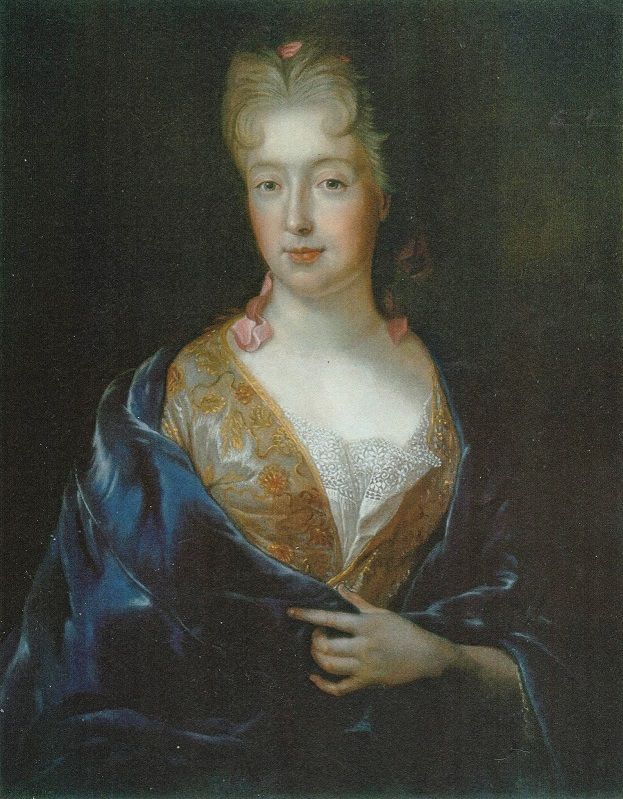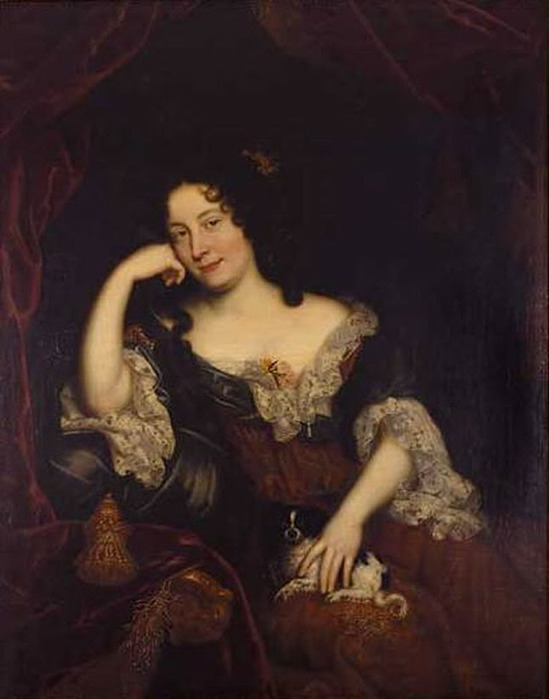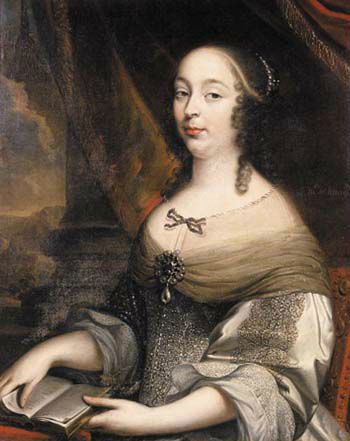Françoise de Brancas, Princesse d’Harcourt
Louis XIV’s court was full with strange people and if the stories regarding the Princesse d’Harcourt are true, she is certainly on the very top of the list.

Françoise de Brancas was born in around 1650 as the oldest daughter of Charles de Brancas, Marquis de Maubec, and his wife Suzanne Garnier. The family was quite respectable and her papa, among other things, served as Chevalier d’Honneur to Anne d’Autriche. Françoise had a younger sister, Marie, who later became a Dame d’Honneur to Madame.
Mademoiselle de Brancas married rather well. The groom who was chosen for her was Alphonse-Henri-Charles de Lorraine, whose grandmother was Catherine-Henriette de Bourbon, an illegitimate daughter of Henri IV. Their marriage took place on 21 February 1667 in Paris. Françoise was a true beauty at that time with perfect skin and luscious hair. Her hubby was quite the soldier and being a Lorraine, he was of course très noble.
In matters of producing children, the marriage was a success. Ten children were born to the couple between 1668 and 1686… the hubby however was not entirely faithful and made merry with plenty of ladies… or rather whoever fell for the Lorraine-charm.
With her marriage, Françoise was given a position as Dame d’Honneur to Marie-Thérèse d’Autriche and that put her into the spotlight. The Queen’s ladies were the King’s hunting-grounds and thus those ladies always tried to look their very best. Françoise, very proud of her beauty and perfect skin, tried to keep up with the likes of a Madame de Montespan, by covering her face with all sorts of beauty products… of which many were poisonous. The effect of those products, were the very contrary to what she had hoped.
Contemporaries describe Françoise de Brancas as quite arrogant and short-tempered, she counted among her friend many people of great importance, like Madame de Maintenon… and then there was Saint-Simon. The Duc, or rather what he wrote about her, is the reason for the bad image Françoise has today. Saint-Simon was not a friend of the Lorraine’s and wrote badly about most of them, yet what he wrote about Françoise could be called slandering. How true those stories are in their details is hard to tell…

The Princesse was of an advanced age already, in her fifties, as Saint-Simon described her thus: “She was a sort of personage whom it is good to make known, in order better to lay bare a court which did not scruple to receive such as she. She had once been beautiful and gay; but though not old, all her grace and beauty had vanished. The rose had become an ugly thorn. At the time I speak of she was a tall, fat creature, mightily brisk in her movements, with a complexion like milk porridge; great, ugly, thick lips, and hair like tow, always sticking out and hanging down in disorder, like all the rest of her fittings out.“ and “Dirty, slatternly, always intriguing, pretending, enterprising, quarreling always low as the grass or high as the rainbow, according to the person with whom she had to deal.”
He also accused her of cheating at cards: “Whenever money was to be made by scheming and bribery, she was there to make it. At play she always cheated, and if found out stormed and raged; but pocketed what she had won. People looked upon her as they would have looked upon a fish-fag, and did not like to commit themselves by quarreling with her. At the end of every game she used to say that she gave whatever might have been unfairly gained to those who had gained it, and hoped that others would do likewise. For she was very devout by profession, and thought by so doing to put her conscience in safety; because, she used to add, in play there is always some mistake. She went to church always, and constantly took the sacrament, very often after having played until four o’clock in the morning.”
…and to relief herself whenever she pleased: “She was a blonde Fury, nay more, a Harpy: she had all the effrontery of one, and the deceit and violence; all the avarice and the audacity: moreover, all the gluttony, and all the promptitude to relieve herself from the effects thereof; so that she drove out of their wits those at whose house she dined; was often a victim of her confidence; and was many a time sent to the Devil by the servants of Monsieur du Maine and Monsieur le Grand. She was never in the least embarrassed, however, tucked up her petticoats and went her way; then returned, saying she had been unwell. People were accustomed to it.”
Also her servants had to suffer: “The Princesse d’Harcourt paid her servants so badly that they concocted a return. One fine day they drew up on the Pont Neuf; the coachmen and footmen got down, and came and spoke to her at the door in language she was not used to hear. Her ladies and chambermaid got down and went away, leaving her to shift as she might. Upon this she set herself to harangue the blackguards who collected, and was only too happy to find a man who mounted upon the seat and drove her home. Another time, Madame de Saint-Simon, returning from Versailles, overtook her walking in full dress in the street, and with her train under her arms. Madame de Saint-Simon stopped, offered her assistance, and found she had been again left by her servants on the Pont Neuf. It was volume second of that story; and even when she came back she found her house deserted, every one having gone away at once by agreement. She was very violent with her servants, beat them, and changed them every day. Upon one occasion, she took into her service a strong and robust chambermaid, to whom, from the first day of her arrival, she gave many slaps and boxes on the ear. The chambermaid said nothing, but after submitting to this treatment for five or six days, conferred with the other servants; and one morning, while in her mistress’s room, locked the door without being perceived, said something to bring down punishment upon her, and at the first box on the ear she received, flew upon the Princesse d’Harcourt, gave her no end of thumps and slaps, knocked her down, kicked her, mauled her from her head to her feet, and when she was tired of this exercise, left her on the ground, all torn and disheveled, howling like a devil. The chambermaid then quitted the room, double-locked the door on the outside, gained the staircase, and fled the house.”

….adding that: “Every day the princess was fighting, or mixed up in some adventures. Her neighbours at Marly said they could not sleep for the riot she made at night; and I remember that after one of these scenes, everybody went to see the room of the Duchesse de Villeroy and that of Madame d’Espinoy, who had put their beds in the middle of their room, and who related their night vigils to every one. Such was this favourite of Madame de Maintenon; so insolent and so insupportable to every one, but who had favours and preferences for those who brought her over, and who had raised so many young men, amassed wealth for them, and made herself feared even by the prince and minister.”
The Princesse obviously knew how to hand out, but she was also often on the receiving side of things: “Monseigneur le Duc and Madame la Duchesse de Bourgogne continually played off pranks upon her. They put, one day, crackers all along the avenue of the château at Marly, that led to the Perspective where she lodged. She was horribly afraid of everything. The Duc and Duchesse bribed two porters to be ready to take her into the mischief. When she was right in the middle of the avenue the crackers began to go off, and she to cry aloud for mercy; the chairmen set her down and ran for it. There she was, then, struggling in her chair furiously enough to upset it, and yelling like a demon. At this the company, which had gathered at the door of the château to see the fun, ran to her assistance, in order to have the pleasure of enjoying the scene more fully. Thereupon she set to abusing everybody right and left, commencing with Monseigneur and Madame la Duchesse de Bourgogne. At another time Monsieur de Bourgogne put a cracker under her chair in the salon, where she was playing at piquet. As he was about to set fire to this cracker, some charitable soul warned him that it would maim her, and he desisted. Sometimes they used to send about twenty Swiss guards, with drums, into her chamber, who roused her from her first sleep by their horrid din. Another time—and these scenes were always at Marly—they waited until very late for her to go to bed and sleep. She lodged not far from the post of the Captain of the Guards, who was at that time the Maréchal de Lorges. It had snowed very hard, and had frozen. Madame la Duchesse de Bourgogne and her suite gathered snow from the terrace which is on a level with their lodgings; and in order to be better supplied, waked up to assist them the Maréchal’s people, who did not let them want for ammunition. Then with a false key and lights, they gently slipped into the chamber of the Princesse d’Harcourt; and suddenly drawing the curtains of her bed, pelted her amain with snowballs. The filthy creature, waking up with a start, bruised and stifled in snow, with which even her ears were filled, with dishevelled hair, yelling at the top of her voice, and wriggling like an eel, without knowing where to hide, formed a spectacle that diverted people more than half an hour; so that at last the nymph swam in her bed, from which the water flowed everywhere, slushing all the chamber. It was enough to make one die of laughter. On the morrow she sulked, and was more than ever laughed at for her pains. Her fits of sulkiness came over her either when the tricks played were too violent, or when Monsieur le Grand abused her. He thought, very properly, that a person who bore the name of Lorraine should not put herself so much on the footing of a buffoon: and as he was a rough speaker, he sometimes said the most abominable things to her at table; upon which the Princesse would burst out crying, and then, being enraged, would sulk. The Duchesse de Bourgogne used then to pretend to sulk too; but the other did not hold out long, and came crawling back to her, crying, begging pardon for having sulked, and praying that she might not cease to be a source of amusement! After some time the Duchesse would allow herself to be melted, and the princess was more villainously treated than ever; for the Duchesse de Bourgogne had her own way in everything: neither the King nor Madame de Maintenon found fault with what she did, so that the Princesse d’Harcourt had no resource; she did not even dare to complain of those who aided in tormenting her: yet it would not have been prudent in any one to make her an enemy.”

All those tales about the Princesse, make her seem to be quite a sorry person. Someone who was picked on by others and then picked in turn on others. What Saint-Simon does not mention at all, is the fact that the Princesse did quite a bit of good as well. In the small town of Harcourt and other properties of the family, she was known to be quite the angel. Probably inspired by Madame de Maintenon’s Saint-Cyr, the Princesse had a hospice built Harcourt. The hospice opened its doors in 1695 and served as a home for poor elderly people and also had a girl’s school. Young girls from not so fortunate families, could learn how to create lace and were provided with a basic education.
Françoise de Brancas died in April 1715, as she was around sixty years old, after a short illness.





